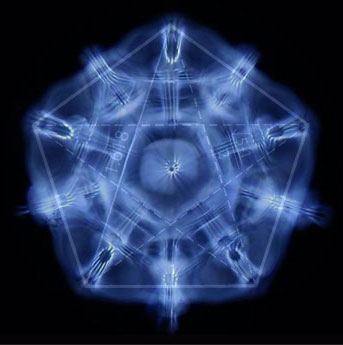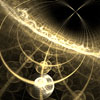When we say some element of the quantum world occupies many states at once, what’s really being referred to is the element’s wave function. A wave function can be viewed as a space occupied simultaneously by many different possibilities or degrees of freedom.
If a particle could be in position (x,y,z) in three-dimensional space, there are probabilities that it could specifically be at (x1,y1,z1) or (x2,y2,z2) and so forth, and this is represented in the wave function, which is all of these possibilities added together. Even what we’d normally (deterministically) consider empty space has a wave function and, as such, contains very real possibilities of not being empty. Sometimes this manifests as real “virtual” particles.
Visually, we might imagine a particle in its undisturbed state looking more like a cloud than a point in space. Imagine tracing out all of your movements for a couple of weeks or months on a map or satellite image. It might look a bit like that cloud, only instead of describing past events, the electron cloud would describe precisely right now. Weird, eh? What makes it even cooler is that a bunch of particles can share these states at the same time, effectively becoming instances of the same particle. And so: entanglement.
It’s possible to strip away all of this indeterminateness. To do so is actually quite easy; wave functions are very fragile, subject to a “collapse” in which all of those possibilities become just a single particle at a single point at a single time. That’s what happens when a macroscopic human attempts to measure a quantum mechanical system: The wave drops away and all that’s left is a boring, well-defined thing.
The two probabilities can be isolated from each other, cordoned off like quantum crime scenes
What the Brown researchers, led by physicist Humphrey Maris, found is that it’s possible to take a wave function and isolate it into different parts. So, if our electron has some probability of being in position (x1,y1,z1) and another probability of being in position (x2,y2,z2), those two probabilities can be isolated from each other, cordoned off like quantum crime scenes. According to Maris and his team, this can be achieved (and has been achieved) using tiny bubbles of helium as physical “traps.”
“We are trapping the chance of finding the electron, not pieces of the electron,” Maris said in a statement provided by Brown University. “It’s a little like a lottery. When lottery tickets are sold, everyone who buys a ticket gets a piece of paper. So all these people are holding a chance and you can consider that the chances are spread all over the place. But there is only one prize—one electron—and where that prize will go is determined later.”
Maris is chasing a fairly old mystery with this work. In experiments dating back to the 1960s, physicists have observed a very peculiar behavior of electrons in supercooled baths of helium. When an electron enters the bath, it acts to repel the surrounding helium atoms, forming its own little bubble or cavity in the process. These bubbles then drift slowly downwards toward the bottom of the bath and a waiting detector. The bubbles should all be the same size and, thus, should fall at the same rate. Yet, something much stranger happens.
The electron bubbles aren’t the first things to hit the detector in this experimental setup. Before they arrive as anticipated, the detector begins registering a series of mystery objects. This has been repeated many times over the years and explanations have included impurities in the helium bath or the possibility of electrons coupling to the helium atoms, which would then register negative charges at the detector.
The Brown team argues that the only explanation that fits is their solution, a sort of fission reaction that breaks apart the electron wave function into roughly the same sizes of the mystery objects detected above. So, it’s not new and different objects hitting the detector first, it’s just different aspects or relics of the same electron, slivers of that cloud of possibilities. That an electron (or other particle) can be in many places at the same time is strange enough, but the notion that those possibilities can be captured and shuttled away adds a whole new twist.
Ultimately, the wave function isn’t a physical thing. It’s mathematics that describe a phenomenon. So, it’s not as if in these extra bubbles we might find some “part” of an electron. The electron, upon measurement, will be in precisely one bubble. Or that would be the case if we assume the helium itself isn’t capable of causing the same sort of disturbance as a human measurement, causing its own wave function collapse with its own sort of “measurement.”
“No one is sure what actually constitutes a measurement,” Maris said. “Perhaps physicists can agree that someone with a Ph.D. wearing a white coat sitting in the lab of a famous university can make measurements. But what about somebody who really isn’t sure what they are doing? Is consciousness required? We don’t really know.”







[…] The electron and other particles are just nodal vibrations, where the frequencies are a little more compact but yet in continuous oscillation; this could explain why the particles appear to be in many places at the same time. This also may explain how the harmonics and sub-harmonics of the wave forms that compose particles such as the electron could be caught as slivers in the helium bath experiment as described in the prior article. […]